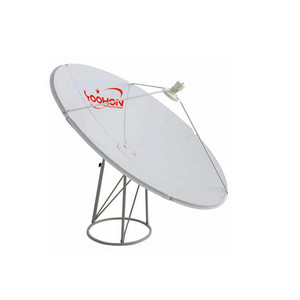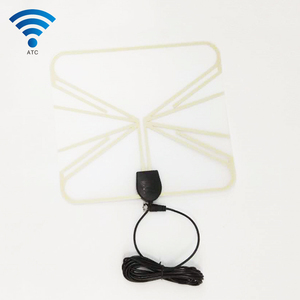Types of indoor satellite dishes
An indoor satellite dish is a device that helps in the reception of satellite signals to deliver television and internet content to an indoor setting. It is also known as a satellite antenna. Even though dishes are usually installed outdoors, many people prefer using indoor dishes because they are more attractive and easier to install and maintain.
Types of indoor satellite dishes are as follows:
- Micro dish: These are very small DVB-S and DVB-S2 dishes that can be as small as 35 cm that provide satellite TV reception. In the past, dishes had to be quite large to receive satellite signals, but technological advancements have made it possible for smaller dishes to work just as well. A micro dish is a great option for a small house or an indoor setting.
- DiSEqC motors: These are not dishes but devices that allow one dish to steer to different satellites. They work with small to medium-sized dishes and are a perfect choice for those who want to receive signals from multiple satellites with just one dish installed in their indoors.
- Ku-band or Ka-band antenna: Indoor satellite dishes are often referred to as antennas and not dishes when they operate in the Ku or Ka bands. These bands are types of frequency where satellite communication signals are transmitted.
- Offset or low-profile dishes: These types of dishes are designed to take up less space, and as the name suggests, they have a low profile. This makes them great for indoor installations. Offset dishes have a mounting arrangement that keeps the feed away from the center of the dish, thereby minimizing its visual impact.
- Portable indoor dishes: These are simple to set up and move from one place to another. They are usually used when people want to access satellite signals in locations where fixed installations are not allowed.
Features and Functions of Indoor Satellite Dish
The functions of indoor satellite dishes are pretty much the same as those of out-door dishes; they receive signals from space satellites and transmit those signals to tuners and TV sets. However, speculation is that the signals received by indoor dishes are inferior to those received by the outdoor dishes; that is why many people prefer the outdoor ones. Nevertheless, indoor satellite dishes have become very popular in recent times due to their convenience, portability, and ease of installation.
Below are some of the features of indoor dishes:
- Ease of installation: indoor satellite dishes are way simpler to install than their outdoor counterparts. Most of them come pre-installed, which reduces the installation time and effort greatly. Even the ones that don't arrive pre-installed can be installed easily in about 30 minutes or less. They can be mounted on windows, railings, or garden fences using suction cups or clamps.
- Portability: another great feature of indoor dishes is their portability. Most satellite dishes are heavy and bulky, thus making them difficult to move around. But the indoor dishes are lightweight and small, which allows them to be easily moved from one location to another.
- Weatherproof: since indoor dishes are used inside, they don't get affected by weather conditions like rain, snow, or wind, which helps improve satellite signal reception.
- Range of mounts: indoor dishes have a wide range of mounts, from clamp mounts to suction cup mounts. This allows them to be mounted in different locations and positions to optimize the reception of signal satellites.
- Less signal interference: since indoor satellites are installed at the home’s location of best signal, they are likely to receive good satellite signals with less interference. They also have less obstacles or interference in the form of trees, buildings, etc. getting in the way of satellite signals.
- Compact design: indoor dishes generally have a compact and streamlined design that allows them to fit neatly into any setup without taking up too much space. Their design is aesthetically pleasing, too.
- Multi-room capability: indoor dishes offer the option of multi-room capability, which allows users to access satellite TV in multiple rooms within their house. The feature enhances the convenience and flexibility of viewing satellite TV. One can watch TV in any tunner, from the living room to the bedroom, with the whole family accessing satellite TV simultaneously in different rooms.
Scenarios of indoor satellite dish
Satellite dishes serve numerous purposes, extending beyond entertainment and residential uses into the commercial arena with some organizations opting to leverage this technology as a means of communication. Here are the different application areas of the indoor satellite antenna;
- Residential use: Indoor satellite TV dishes allow people to view satellite television channels and receive numerous international and local channels with reliable indoor satellite dish receiving signals even in bad weather conditions.
- CCTV camera: Indoor satellite dishes can be used with compatible IP or CCTV cameras to monitor indoor areas such as shops, homes, or offices. Integrating a surveillance camera with an indoor dish can offer real-time monitoring and added security to indoor environments.
- Education institutions: Schools or educational institutions may utilize satellite dishes to receive educational programs, multimedia content, or satellite-based learning materials. Indoor satellite dishes can ensure that such information is accessible for teaching or learning purposes, even in areas with no direct access to cable TV.
- Public facilities: Hospitals, airports, or hotels have indoor satellite dishes installed to offer entertainment services in waiting lounges, lobbies, or guest rooms. Connecting televisions to the dish allows these establishments to provide various channels for guests or patients to enjoy.
- Signal replication: The indoor dish can be used to replicate or redistribute a satellite signal within a building or area where direct line-of-sight to the satellite is obstructed. This ensures that multiple receivers or tuners have access to the satellite signal.
- Monitoring satellite data: Indoor dishes with compatible receivers or monitoring equipment can be used to track satellite data, weather information, or other satellite-based information. Research institutions or agencies may use this to monitor satellites or collect data transmitted by satellites.
- Backup communication: In case of a commercial indoor dish antenna that provides internet connectivity, in case of network failure, it can serve as a backup communication tool for businesses to ensure they can continue to communicate and operate even in network outages.
- Government or military usage: Indoor satellite dishes can be used for government or military purposes for communication, intelligence gathering, or other satellite-based operations.
How to choose indoor satellite dish
When purchasing an indoor satellite dish for sale, buyers should consider dishes that support their specific TV and satellite service. Indoor satellite dishes tend to be small and limited in supporting a specific number of transponders which are the frequency channels of a satellite.
A specialized indoor satellite dish will have a larger LNB (a key element of any satellite dish that receives signals) that can support more transponders in case more channels are desired later. In case a larger number of channels are desired, buyers should go for the largest dish possible.
Indoor dishes are limited in their ability to scan for satellite signals because of space constraints. If a larger dish is to be mounted outdoors, buyers can purchase an indoor satellite TV receiver that is capable of more signal scanning. The size and capabilities of the receiver can work closely with the satellite dish.
One of the strongest factors in deciding which dish to purchase is location. Location has a strong impact on the ability of a dish to receive stable satellite signals. Indoor dishes can face obstacles such as trees or buildings that can hinder signal strength. If good signal strength can be confirmed in the area, then a smaller indoor dish can be purchased and can provide stable signal reception.
Installation is another important factor to consider when purchasing an indoor satellite dish. Dishes that are more portable and easier to install will be preferred as they offer the flexibility to be moved around in the home in order to find the best satellite signal reception. Some indoor dishes can be installed on the roof of a home and can be run down through a pipe into a room to connect the TV. In such cases, a coax cable will connect the dish to the TV receiver. Indoor dishes that carry televisions from room to room will prefer dishes that are easy to transport and move around.
Q & A
Q: Can indoor satellite dishes work through walls or windows?
A: Most indoor dishes need a clear view of the sky to work. Ku-band dishes may work through thin walls or windows, but only sometimes. LNBF and asegurar modules should be mounted outside for best results.
Q: How many TVs can a dish serve?
A: One receiver can connect to multiple TVs with a multi-room setup. Each TV would need a separate receiver or adapter. Check system limits, as some setups only allow a certain number of simultaneous viewers.
Q: How does天气 affect reception?
A:晴天 usually causes no problems. Heavy rain, snow, or storms can disrupt signals sometimes. Indoor dishes may have better雨受不了. C-band can handle the weather better than Ku-band.
Q: Can dishes be moved for camping or travel?
A: Some portable satellite dishes allow signal tuning for camping or moving. Most indoor dishes are固定的 and meant only for home use.
Q: What is the indoor satellite dish's maintenance?
A: Indoor satellite dishes require少量保养. Periodically check cables to ensure they are正常工作.清洁卫星天线可以帮助确保最佳性能。如果有任何明显的磨损或故障迹象,替换受影响的部件。随时从制造商处获取软件更新,以确保收发器以最新的状态运行并具有最佳的功能。大多数卫星天线都设计成经受住户外环境,要定期为其提供保障,以确保长期稳定运行。

































































































































































